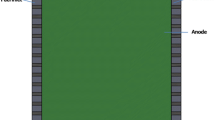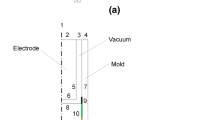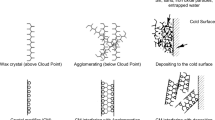Abstract
For the advantages of environment-friendly decomposition product, fireproofing, and low cost, the water or water-based dielectric is widely used in die-sinking electrical discharge machining (EDM) and wire EDM, especially in the high-efficiency electrical erosion process. In order to study the process of EDM in water, in this paper, a theoretical spark column expansion formula has been derived instead of directly using the previous empirical expressions for EDM in oil dielectric. It is found that the approximate expression of the proposed formula is extremely close to the previously widely used empirical expression for EDM in oil dielectric when the parameters are selected appropriately. The corresponding parameters for EDM in water are determined according to the dimensions of experimentally obtained craters. The proposed theoretical formula reveals that the total heat transfer time decreases radially from the center to the periphery at the spark/anode interface rather than equals to the pulse on time everywhere. This phenomenon can be considered as the time integration effect (TIE) caused by the expanding spark, and it has been calculated quantitatively based on the derived formula. Finally, a finite element thermal model considering the TIE has been developed. The results of craters and material removal rate (MRR) predicted by the proposed model show a close agreement with experimental results, which indicates that the developed thermal model can be used to study the spark expansion rule and understand the EDM process.
Similar content being viewed by others
References
Abdulkareem S, Khan AA, Konneh M (2009) Reducing electrode wear ratio using cryogenic cooling during electrical discharge machining. Int J Adv Manuf Technol 45(11–12):1146–1151
Chiang K-T (2008) Modeling and analysis of the effects of machining parameters on the performance characteristics in the EDM process of Al2O3 + TiC mixed ceramic. Int J Adv Manuf Technol 37(5–6):523–533
Snoeys R, Van Dijck FS (1971) Investigation of electro discharge machining operations by means of thermo-mathematical model. CIRP Ann 20(1):35–37
Van Dijck FS, Dutre WL (1974) Heat conduction model for the calculation of the volume of molten metal in electric discharges. J Phys D Appl Phys 7(6):899–910
Patel MR, Barrufet MA, Eubank PT, DiBitonto DD (1989) Theoretical models of the electrical discharge machining process. II. The anode erosion model. J Appl Phys 66(9):4104–4111
Natsu W, Shimoyamada M, Kunieda M (2006) Study on expansion process of EDM arc plasma. JSME Int J Ser C 49(2):600–605
Yeo SH, Kurnia W, Tan PC (2007) Electro-thermal modelling of anode and cathode in micro-EDM. J Phys D Appl Phys 40(8):2513
Joshi SN, Pande SS (2010) Thermo-physical modeling of die-sinking EDM process. J Manuf Process 12(1):45–56
Tao J, Ni J, Shih AJ (2012) Modeling of the anode crater formation in electrical discharge machining. J Manuf Sci Eng 134(1):011002
Hui Z, Liu Z, Qiu M, Wang X, Cao Z (2014) Discharge characteristics of cool electrode in EDM based on monopulse discharge. Int J Adv Manuf Technol 75(5–8):731–738
Somashekhar KP, Panda S, Mathew J, Ramachandran N (2013) Numerical simulation of micro-EDM model with multi-spark. The International Journal of Advanced Manufacturing Technology pp. 1–8
Murali MS, Yeo SH (2005) Process simulation and residual stress estimation of micro-electrodischarge machining using finite element method. Jpn J Appl Phys 44(7):5254
Zhang Y, Liu Y, Ji R, Zheng C, Shen Y, Wang X (2013) Transient dynamics simulation of the electrical discharge-generated bubble in sinking EDM. Int J Adv Manuf Technol 68(5–8):1707–1715
Giridharan A, Samuel, GL (2014) Modeling and analysis of crater formation during wire electrical discharge turning (WEDT) process. The International Journal of Advanced Manufacturing Technology pp. 1–19
Zhao W, Gu L, Xu H, Li L, Xiang X (2013) A novel high efficiency electrical erosion process-blasting erosion arc machining. Procedia CIRP 6:621–625
Eubank PT, Patel MR, Barrufet MA, Bozkurt B (1993) Theoretical models of the electrical discharge machining process. III. The variable mass, cylindrical plasma model. J Appl Phys 73(11):7900–7909
DiBitonto DD, Eubank PT, Patel MR, Barrufet MA (1989) Theoretical models of the electrical discharge machining process. I. A simple cathode erosion model. J Appl Phys 66(9):4095–4103
Zingerman AS (1956) The effect of thermal conductivity upon the electrical erosion of metals. Soviet Phys-Tech Phys
Ikai T, Hashigushi K (1995) Heat input for crater formation in EDM. Proceedings of international symposium for electro-machining, ISEM XI, EPFL, Lausanne
Salonitis K, Stournaras A, Stavropoulos P, Chryssolouris G (2009) Thermal modeling of the material removal rate and surface roughness for die-sinking EDM. Int J Adv Manuf Technol 40(3–4):316–323
Kojima A, Natsu W, Kunieda M (2008) Spectroscopic measurement of arc plasma diameter in EDM. CIRP Ann Manuf Technol 57(1):203–207
Xia H, Kunieda M, Nishiwakin N (1996) Removal amount difference between anode and cathode in EDM process. Int J Electr Mach 1:45–52
Zhang Y, Liu Y, Shen Y, Li Z, Ji R, Wang F (2013) A new method of investigation the characteristic of the heat flux of EDM plasma. Procedia CIRP 6:450–455
Yeo SH, Kurnia W, Tan PC (2008) Critical assessment and numerical comparison of electro-thermal models in EDM. J Mater Process Technol 203(1):241–251
Dhanik S, Joshi SS (2005) Modeling of a single resistance capacitance pulse discharge in micro-electro discharge machining. J Manuf Sci Eng 127(4):759–767
Author information
Authors and Affiliations
Corresponding author
Rights and permissions
About this article
Cite this article
Zhang, F., Gu, L., Hu, J. et al. A new thermal model considering TIE of the expanding spark for anode erosion process of EDM in water. Int J Adv Manuf Technol 82, 573–582 (2016). https://doi.org/10.1007/s00170-015-7389-3
Received:
Accepted:
Published:
Issue Date:
DOI: https://doi.org/10.1007/s00170-015-7389-3




